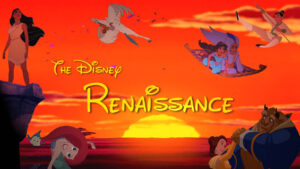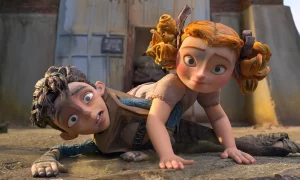The Evolution of Animation

Animation has come a long way since its early days. From the charming hand-drawn classics of the past to the visually stunning 3D masterpieces of today, the world of animation has continually evolved, pushing the boundaries of creativity and technology. In this blog post, we’ll take a journey through the history of animation, exploring its major milestones and the innovations that have shaped this beloved art form. The evolution of animation refers to the historical development and transformation of the animation industry, techniques, and technologies from its earliest beginnings to the present day. This evolution has been marked by significant milestones and innovations that have shaped the art and industry of animation.

The Golden Age of Hand-Drawn Animation: The origins of animation can be traced back to the late 19th century, but it was during the early 20th century that hand-drawn animation truly began to flourish. Studios like Walt Disney Productions and Warner Bros. introduced iconic characters like Mickey Mouse and Bugs Bunny, forever changing the landscape of entertainment. We’ll delve into the magic of these classic animations and the groundbreaking techniques used to bring them to life.

The Disney Renaissance: The 1980s and 1990s marked a renaissance for Disney animation, with films like “The Little Mermaid,” “Beauty and the Beast,” and “The Lion King” captivating audiences worldwide. We’ll explore how these films not only revived Disney’s animation department but also set new standards for storytelling and animation quality. The Disney Renaissance also saw advancements in computer animation with films like “The Rescuers Down Under” (1990).

The Rise of Computer Animation: The late 20th century brought about a revolution in animation with the advent of computer-generated imagery (CGI). Pixar’s “Toy Story” in 1995 was a game-changer, proving that 3D animation could be emotionally resonant and commercially successful. We’ll discuss the impact of CGI on animation and its continued dominance in the industry.

Stop-Motion and Beyond: Animation isn’t limited to just 2D or 3D techniques. Stop-motion animation, popularized by studios like Aardman Animations (“Wallace and Gromit”) and Laika (“Coraline”), offers a unique and tactile approach to storytelling. We’ll highlight the charm and artistry of stop-motion animation and its enduring appeal.
- The 21st century brought about the use of digital tools in both 2D and 3D animation.
- The growth of streaming platforms like Netflix and Disney+ has led to a resurgence of animated content, including original series and films.

The Future of Animation: As technology continues to advance, so does the world of animation. We’ll touch on emerging trends like virtual reality (VR) animation and interactive storytelling, which promise to redefine the way we experience animated content in the digital age. Animation is likely to continue evolving with the integration of augmented reality (AR) and virtual reality (VR) technologies. Artificial intelligence and machine learning may play a role in automating certain aspects of animation production.
Conclusion: Animation has a rich and storied history, from its humble beginnings to its current status as a global entertainment powerhouse. As we look back on the evolution of animation, we can’t help but be excited about the limitless possibilities that lie ahead. Animation has always been about pushing boundaries, and it’s a journey that we’re eager to continue exploring in the years to come.
Whether you’re a fan of hand-drawn classics, CGI extravaganzas, or something in between, animation has something for everyone. It’s a testament to the power of creativity, innovation, and storytelling—a true art form that continues to capture our hearts and imaginations.
The evolution of animation has been a remarkable journey, from the simple devices of the late 19th century to the sophisticated, computer-generated spectacles of today. It has continually pushed the boundaries of creativity, technology, and storytelling, captivating audiences of all ages across the globe.
History of animation
Certainly, here’s an in-depth history of animation, spanning over a century and covering significant milestones, innovations, and key figures in the world of animation.
Introduction to Animation:
Animation is a captivating art form that brings inanimate objects and drawings to life through a series of images or frames displayed in rapid succession. Its roots can be traced back to the early experiments in visual perception and the persistence of vision. Let’s embark on a journey through the rich history of animation, from its humble beginnings to the digital revolution of the 21st century.
Early Experiments in Animation (19th Century):
The origins of animation can be found in the 19th century when inventors and artists were intrigued by the phenomenon of persistence of vision, where the human eye retains an image for a fraction of a second after it disappears. Several early devices were created to explore this concept:
- Thaumatrope (1824): John Ayrton Paris, an English physician, invented the thaumatrope, a simple spinning disc with different images on each side. When spun, it created the illusion of a combined image.
- Zoetrope (1834): William George Horner, an English mathematician, introduced the zoetrope, a cylindrical device with slits that allowed viewers to look inside. When the cylinder was spun, it created the illusion of motion as viewers saw a sequence of images through the slits.
- Phenakistoscope (1832): Belgian physicist Joseph Plateau developed the phenakistoscope, which featured a spinning disc with sequential images and a mirror. When viewed through the slits while spinning, it gave the impression of animation.
Birth of Animation Pioneers (Early 20th Century):
The early 20th century saw the emergence of individuals who pushed the boundaries of animation and laid the foundation for the industry’s future:
- Émile Cohl (1908): French cartoonist Émile Cohl created “Fantasmagorie,” one of the earliest examples of hand-drawn animation. It featured a stick figure that transformed into various shapes and objects.
- Winsor McCay (1914): McCay, an American cartoonist and animator, made “Gertie the Dinosaur,” a groundbreaking animation that showcased a character interacting with its creator, demonstrating the potential of storytelling in animation.
Disney and the Golden Age (1920s-1940s):
The 1920s marked the rise of animation as a popular form of entertainment. Walt Disney played a pivotal role in shaping the industry:
- Walt Disney (1923): Walt Disney, along with his brother Roy O. Disney, founded the Disney Brothers Studio, which later became The Walt Disney Company, a powerhouse in the animation world.
- “Steamboat Willie” (1928): Disney introduced synchronized sound to animation with “Steamboat Willie,” the debut of Mickey Mouse. This innovation revolutionized the medium.
- “Snow White and the Seven Dwarfs” (1937): Disney released the first full-length animated feature film, “Snow White and the Seven Dwarfs,” setting a new standard for storytelling and animation quality.
- Technicolor (1930s): The adoption of Technicolor technology allowed for the creation of full-color animated films like Disney’s “Flowers and Trees” (1932), which won the first Academy Award for Best Animated Short.
Innovations and Challenges (1950s-1970s):
The mid-20th century brought both innovation and challenges to animation:
- Xerography (1961): Disney introduced xerography, a photocopying technique, in “One Hundred and One Dalmatians.” This streamlined the animation process and reduced costs.
- Ray Harryhausen (1960s): Ray Harryhausen, a master of stop-motion animation, continued to push the boundaries with films like “Jason and the Argonauts” (1963), featuring intricate creature animation.
- “Yellow Submarine” (1968): This Beatles-inspired film showcased psychedelic and experimental techniques, reflecting the counterculture of the time.
The Rise of Computer Animation (1980s-1990s):
The late 20th century witnessed the emergence of computer-generated imagery (CGI), transforming the animation landscape:
- “Tron” (1982): “Tron” combined live-action and CGI to create a unique visual style, pushing the boundaries of animation.
- The Birth of Pixar (1986): Steve Jobs, Edwin Catmull, and John Lasseter founded Pixar Animation Studios, which would become a pioneering force in CGI animation.
- “Toy Story” (1995): Pixar’s “Toy Story” marked a historic moment as the first feature-length CGI animated film. It was a game-changer in the industry.
The 21st Century Animation Renaissance (2000s-Present):
The 21st century brought about a resurgence of animation and diverse storytelling:
- “Shrek” (2001): DreamWorks’ “Shrek” introduced a new era of animated films with its irreverent humor and subversion of fairy tale tropes.
- “Finding Nemo” (2003): Pixar’s “Finding Nemo” showcased the growing capabilities of CGI animation and depth of storytelling.
- Stop-Motion Resurgence (2009): Henry Selick’s “Coraline” and Wes Anderson’s “Fantastic Mr. Fox” renewed interest in stop-motion animation.
- Streaming and Diversity (2010s): Streaming platforms like Netflix, Amazon Prime, and Disney+ became major players in animation, offering diverse content and original series.
- “Zootopia” (2016): Disney’s “Zootopia” addressed social issues through animation, illustrating the medium’s capacity for relevant storytelling.
- VR and AR Animation (2020s): Virtual Reality (VR) and Augmented Reality (AR) technologies continue to evolve, offering new ways to experience animation.
Independent and Experimental Animation:
- Online Platforms: The digital age empowered independent animators to create and distribute their work on platforms like YouTube, Vimeo, and social media, fostering a thriving independent animation community.
- Adult-Oriented Animation: Shows like “Rick and Morty,” “BoJack Horseman,” and “Big Mouth” gained popularity for their mature themes and humor, expanding the audience for animation.
Here’s an overview of the key stages in the evolution of animation:
- Pre (Before 19th Century):
- Before the invention of motion pictures, there were early attempts to create the illusion of motion through devices like the Zoetrope and the Thaumatrope, which used spinning discs with sequential images.
- Early (Late 19th Century):
- The first experiments in animation began with pioneers like Eadweard Muybridge and Thomas Edison, who used sequential photographs to create motion.
- Emile Reynaud’s “Pantomimes Lumineuses” (1892) is considered one of the earliest examples of projected animation.
- Silent Era (Early 20th Century):
- The silent film era saw the emergence of animation as a distinct art form.
- Winsor McCay’s “Gertie the Dinosaur” (1914) is one of the earliest animated films using traditional hand-drawn animation techniques.
- Max Fleischer introduced “Out of the Inkwell” (1918), featuring Koko the Clown.
- Sound and Color (1930s):
- The advent of sound in film allowed for synchronized music and dialogue in animated shorts.
- The introduction of Technicolor brought vibrant color , leading to classics like Disney’s “Snow White and the Seven Dwarfs” (1937).
- Golden Age (1930s – 1950s):
- Animation studios like Disney, Warner Bros., and MGM produced iconic characters and cartoons during this period.
- Characters like Mickey Mouse, Bugs Bunny, and Tom and Jerry became cultural icons.
- Television Animation (1950s – 1960s):
- The rise of television brought animated series like “The Flintstones” and “The Jetsons” to the forefront.
- Hanna-Barbera Studios became known for creating popular TV animation.
- Disney Renaissance (1980s – 1990s):
- Disney experienced a resurgence with hits like “The Little Mermaid” (1989) and “The Lion King” (1994), combining traditional hand-drawn animation with modern storytelling.
- Digital Animation (1990s – 2000s):
- The advent of computer-generated animation, exemplified by Pixar’s “Toy Story” (1995), marked a significant shift in animation technology.
- DreamWorks and other studios embraced computer-generated imagery (CGI).
- Contemporary Animation (2000s – Present):
- Advances in technology, including 3D animation and digital tools, have expanded the possibilities for animation.
- Streaming platforms and online communities have led to a resurgence of animated content, catering to diverse audiences.
- Future Trends:
- Continues to evolve with advancements in augmented reality (AR), virtual reality (VR), and artificial intelligence (AI).
- The boundaries between live-action and animation continue to blur with the use of CGI in filmmaking.
A Timeline: The Evolution of Animation
I will provide a detailed overview of key milestones and developments in the history.
Early Experiments (19th Century):
- 1824 – Thaumatrope: John Ayrton Paris, an English physician, invented the thaumatrope, a simple optical toy that featured two images on opposite sides of a spinning disc, creating the illusion of a single image.
- 1834 – Zoetrope: William George Horner developed the zoetrope, a cylindrical device with slits through which one could view a sequence of images. When spun, it produced the illusion of motion.
- 1832 – Phenakistoscope: Joseph Plateau, a Belgian physicist, created the phenakistoscope, which used a spinning disc with sequential images and a mirror to create the illusion of animation.
Early Animation Pioneers (Early 20th Century):
- 1906 – J. Stuart Blackton: Blackton, an American filmmaker, created “Humorous Phases of Funny Faces,” often considered one of the earliest examples of stop-motion animation.
- 1908 – Émile Cohl: French cartoonist Émile Cohl made “Fantasmagorie,” a short film that employed hand-drawn animation techniques, making it one of the earliest animated films.
- 1914 – Gertie the Dinosaur: Winsor McCay’s “Gertie the Dinosaur” featured one of the earliest animated characters and showcased the potential for storytelling through animation.
The Emergence of Walt Disney (1920s-1930s):
- 1923 – Disney Brothers Studio: Walt Disney, along with his brother Roy O. Disney, founded the Disney Brothers Studio, which would later become The Walt Disney Company.
- 1928 – “Steamboat Willie”: The introduction of synchronized sound in animation with “Steamboat Willie” marked the debut of Mickey Mouse and a significant advancement in animation.
- 1937 – “Snow White and the Seven Dwarfs”: Disney’s release of the first full-length animated feature film, “Snow White and the Seven Dwarfs,” marked a major milestone in animation history.
Golden Age (1930s-1950s):
- 1930s – Technicolor: The adoption of Technicolor technology allowed for the creation of full-color animated films like Disney’s “Flowers and Trees” (1932).
- **1937 – Disney’s “Dwarfs”: Following “Snow White,” Disney continued to produce successful animated features, including “Pinocchio” (1940), “Dumbo” (1941), “Bambi” (1942), and “Cinderella” (1950).
- 1939 – “Gone with the Wind”: The film “Gone with the Wind” included a groundbreaking use of animated matte paintings to create epic scenes.
Innovations and Expansion (1960s-1970s):
- 1961 – First Xerography : Disney introduced xerography, a photocopying technique, in “One Hundred and One Dalmatians,” which streamlined the animation process.
- 1963 – Ray Harryhausen: Ray Harryhausen continued to advance stop-motion with “Jason and the Argonauts,” featuring intricate creature animation.
- 1968 – “Yellow Submarine”: This Beatles-inspired film showcased psychedelic and experimental animation techniques.
The Rise of Computer Animation (1980s-1990s):
- 1982 – “Tron”: “Tron” combined live-action and computer-generated imagery (CGI) to create a unique visual style, pushing the boundaries of animation.
- 1986 – Pixar Founded: The founding of Pixar Animation Studios by Steve Jobs, Edwin Catmull, and John Lasseter marked the beginning of CGI animation’s rise.
- 1995 – “Toy Story”: Pixar released “Toy Story,” the first feature-length CGI animated film, which transformed the animation industry.
21st Century Animation (2000s-2020s):
- 2001 – “Shrek”: DreamWorks’ “Shrek” introduced a new era of animated films with its irreverent humor and use of pop culture references.
- 2003 – “Finding Nemo”: Pixar’s “Finding Nemo” showcased the growing capabilities of CGI animation and storytelling depth.
- 2009 – Stop-Motion Resurgence: Henry Selick’s “Coraline” and Wes Anderson’s “Fantastic Mr. Fox” renewed interest in stop-motion animation.
- 2010 – 3D Animation Dominance: 3D animated films like “Frozen,” “Despicable Me,” and “The Lego Movie” became box office hits.
- 2016 – “Zootopia”: Disney’s “Zootopia” addressed social issues through animation, illustrating the medium’s capacity for relevant storytelling.
- 2020 – Streaming and Diversity: Streaming platforms like Netflix, Amazon Prime, and Disney+ became major players in animation, offering diverse content.
- 2020s – VR and AR Animation: Virtual Reality (VR) and Augmented Reality (AR) technologies continue to evolve, offering new ways to experience animation.
Independent and Experimental Animation:
- Online Platforms: The digital age has empowered independent animators to create and distribute their work on platforms like YouTube, Vimeo, and social media.
- Adult-Oriented Animation: Shows like “Rick and Morty,” “BoJack Horseman,” and “Big Mouth” have gained popularity for their mature themes and humor.
Conclusion (2020s and Beyond):
The evolution of animation has been a remarkable journey, from the early optical toys of the 19th century to the cutting-edge CGI and immersive technologies of the 21st century. It continues to expand its horizons, reaching new audiences and pushing creative boundaries. With advancements in technology and the increasing diversity of voices in the industry, the future of animation promises even more innovation and creativity.
